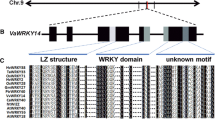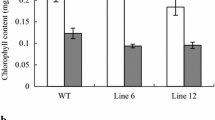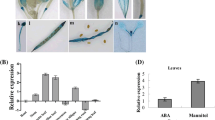Abstract
Arabidopsis thaliana WRKY39, a transcription factor that is induced by heat stress, is a member of the group II WRKY proteins and responds to both abiotic and biotic stress. Heat-treated seeds and plants of WRKY39 knock-down mutants had increased susceptibility to heat stress, showing reduced germination, decreased survival, and elevated electrolyte leakage compared with wild-type plants. In contrast, WRKY39 over-expressing plants exhibited enhanced thermotolerance compared with wild-type plants. RT-PCR and qRT-PCR analysis of wrky39 mutants and WRKY39 over-expressing plants identified putative genes regulated by WRKY39. Consistent with a role for WRKY39 in heat tolerance, the expression levels of salicylic acid (SA)-regulated PR1 and SA-related MBF1c genes were downregulated in wrky39 mutants. In contrast, over-expression of WRKY39 increased the expression of PR1 and MBF1c. The WRKY39 transcript was induced in response to treatment with SA or methyljasmonate. Analysis of heat stress-induced WRKY39 in defense signaling mutants, including coi1, ein2, and sid2, further indicated that WRKY39 was positively co-regulated by the SA and jasmonate (JA) signaling pathways. Together, these findings reveal that heat stress-induced WRKY39 positively regulates the cooperation between the SA- and JA-activated signaling pathways that mediate responses to heat stress.
Similar content being viewed by others
References
Alonso, J.M., Stepanova, A.N., Leisse, T.J., Kim, C.J., Chen, H.M., Shinn, P., Stevenson, D.K., Zimmerman, J., Barajas, P., Cheuk, R., et al. (2003). Genome-wide insertional mutagenesis of Arabidopsis thaliana. Science 301, 653–657.
Balbi, V., and Devoto, A. (2008). Jasmonate signalling network in Arabidopsis thaliana: crucial regulatory nodes and new physiological scenarios. New Phytol. 177, 301–318.
Baniwal, S.K., Bharti, K., Chan, K.Y., Fauth, M., Ganguli, A., Kotak, S., Mishra, S.K., Nover, L., Port, M., Scharf, K.D., et al. (2004). Heat stress response in plants: a complex game with chaperones and more than twenty heat stress transcription factors. J. Biosci. 29, 471–487.
Busch, W., Wunderlich, M., and Schoffl, F. (2005). Identification of novel heat shock factor-dependent genes and biochemical pathways in Arabidopsis thaliana. Plant J. 41, 1–14.
Chen, C.H., and Chen, Z.X. (2002). Potentiation of developmentally regulated plant defense response by AtWRKY18, a pathogen-induced Arabidopsis transcription factor. Plant Physiol. 129, 706–716.
Clarke, S.M., Mur, L.A.J., Wood, J.E., and Scott, I.M. (2004). Salicylic acid dependent signaling promotes basal thermotolerance but is not essential for acquired thermotolerance in Arabidopsis thaliana. Plant J. 38, 432–447.
Clarke, S.M., Cristescu, S.M., Miersch, O., Harren, F.J.M., Wasternack, C., and Mur, L.A.J. (2009). Jasmonates act with salicylic acid to confer basal thermotolerance in Arabidopsis thaliana. New Phytol. 182, 175–187.
Clough, S.J., and Bent, A.F. (1998). Floral dip: a simplified method for Agrobacterium-mediated transformation of Arabidopsis thaliana. Plant J. 16, 735–743.
Dat, J.F., Foyer, C.H., and Scott, I.M. (1998). Changes in salicylic acid and antioxidants during induced thermotolerance in mustard seedlings. Plant Physiol. 118, 1455–1461.
Dat, J.F., Lopez-Delgado, H., Foyer, C.H., and Scott, I.M. (2000). Effects of salicylic acid on oxidative stress and thermotolerance in tobacco. J. Plant Physiol. 156, 659–665.
Dong, J.X., Chen, C.H., and Chen, Z.X. (2003). Expression profiles of the Arabidopsis WRKY gene superfamily during plant defense response. Plant Mol.Biol. 51, 21–37.
Du, L.Q., and Chen, Z.X. (2000). Identification of genes encoding receptor-like protein kinases as possible targets of pathogen- and salicylic acid-induced WRKY DNA-binding proteins in Arabidopsis. Plant J. 24, 837–847.
Eulgem, T., Rushton, P.J., Robatzek, S., and Somssich, I.E. (2000). The WRKY superfamily of plant transcription factors. Trends Plant Sci. 5, 199–206.
Eulgem, T., and Somssich, I.E. (2007). Networks of WRKY transcription factors in defense signaling. Curr. Opin. Plant Biol. 10, 366–371.
Fu, Q.T., Li, S.J., and Yu, D.Q. (2009). Identification of an Arabidopsis nodulin-related protein in heat stress. Mol. Cells 29, 77–84.
Gadjev, I., Vanderauwera, S., Gechev, T.S., Laloi, C., Minkov, I.N., Shulaev, V., Apel, K., Inze, D., Mittler, R., and Van Breusegem, F. (2006). Transcriptomic footprints disclose specificity of reactive oxygen species signaling in Arabidopsis. Plant Physiol. 141, 436–445.
Gong, M., Li, Y.J., Dai, X., Tian, M., and Li, Z.G. (1997). Involvement of calcium and calmodulin in the acquisition of heat-shock induced thermotolerance in maize seedlings. J. Plant Physiol. 150, 615–621.
Guy, C. (1999). The influence of temperature extreme on gene expression, genomic structure, and the evolution of induced tolerance in plants. In Plant responses to environmental stresses, H.R. Lerner, eds. (New York, NY: Marcel Dekker), pp. 497–548.
Hong, S.W., and Vierling, E. (2000). Mutants of Arabidopsis thaliana defective in the acquisition of tolerance to high temperature stress. Proc. Natl. Acad. Sci. USA 97, 4392–4397.
Hong, S.W., Lee, U., and Vierling, E. (2003). Arabidopsis hot mutants define multiple functions required for acclimation to high temperatures. Plant Physiol. 132, 757–767.
Howarth, C.J., Pollock, C.J., and Peacock, J.M. (1997). Development of laboratory-based methods for assessing seedling thermotolerance in pearl millet. New phytol. 137, 129–139.
Howe, G.A. (2004). Jasmonates as signals in the wound response. J. Plant Growth Regul. 23, 223–237.
Jing, S., Zhou, X., Song, Y., and Yu, D. (2009). Heterologous expression of OsWRKY23 gene enhances pathogen defense and dark-induced leaf senescence in Arabidopsis. Plant Growth Regul. 58, 181–190.
Kanna, M., Tamaoki, M., Kubo, A., Nakajima, N., Rakwal, R., Agrawal, G.K., Tamogami, S., Ioki, M., Ogawa, D., Saji, H., et al. (2003). Isolation of an ozone-sensitive and jasmonate- semi-insensitive Arabidopsis mutant (oji1). Plant Cell Physiol. 44, 1301–1310.
Larkindale, J., and Knight, M.R. (2002). Protection against heat stress-induced oxidative damage in Arabidopsis involves calcium, abscisic acid, ethylene, and salicylic acid. Plant Physiol. 128, 682–695.
Larkindale, J., and Huang, B.R. (2005). Effects of abscisic acid, salicylic acid, ethylene and hydrogen peroxide in thermotolerance and recovery for creeping bentgrass. Plant Growth Regul. 47, 17–28.
Larkindale, J., Hall, J.D., Knight, M.R., and Vierling, E. (2005). Heat stress phenotypes of Arabidopsis mutants implicate multiple signaling pathways in the acquisition of thermotolerance. Plant Physiol. 138, 882–897.
Larkindale, J., and Vierling, E. (2008). Core genome responses involved in acclimation to high temperature. Plant Physiol. 146, 748–761.
Li, S.J., Fu, Q.T., Huang, W.D., and Yu, D.Q. (2009). Functional analysis of an Arabidopsis transcription factor WRKY25 in heat stress. Plant Cell Rep. 28, 683–693.
Liu, H.T., Gao, F., Li, G.L., Han, J.L., Liu, D.L., Sun, D.Y., and Zhou, R.G. (2008). The calmodulin-binding protein kinase 3 is part of heat-shock signal transduction in Arabidopsis thaliana. Plant J. 55, 760–773.
Lopez-Delgado, H., Dat, J.F., Foyer, C.H., and Scott, I.M. (1998). Induction of thermotolerance in potato microplants by acetylsalicylic acid and H2O2. J. Exp. Bot. 49, 713–720.
Miller, G., Shulaev, V., and Mittler, R. (2008). Reactive oxygen signaling and abiotic stress. Physiol. Plant 133, 481–489.
Mishra, S.K., Tripp, J., Winkelhaus, S., Tschiersch, B., Theres, K., Nover, L., and Scharf, K.D. (2002). In the complex family of heat stress transcription factors, HSfA1 has a unique role as master regulator of thermotolerance in tomato. Genes Dev. 16, 1555–1567.
Panchuk, II., Volkov, R.A., and Schoffl, F. (2002). Heat stress- and heat shock transcription factor-dependent expression and activity of ascorbate peroxidase in Arabidopsis. Plant Physiol. 129, 838–853.
Park, C.Y., Lee, J.H., Yoo, J.H., Moon, B.C., Choi, M.S., Kang, Y.H., Lee, S.M., Kim, H.S., Kang, K.Y., Chung, W.S., et al. (2005). WRKY group IId transcription factors interact with calmodulin. FEBS Lett. 579, 1545–1550.
Pnueli, L., Liang, H., Rozenberg, M., and Mittler, R. (2003). Growth suppression, altered stomatal responses, and augmented induction of heat shock proteins in cytosolic ascorbate peroxidase (Apx1)-deficient Arabidopsis plants. Plant J. 34, 185–201.
Rao, M.V., Lee, H., Creelman, R.A., Mullet, J.E., and Davis, K.R. (2000). Jasmonic acid signaling modulates ozone-induced hypersensitive cell death. Plant Cell 12, 1633–1646.
Rizhsky, L., Liang, H.J., and Mittler, R. (2002). The combined effect of drought stress and heat shock on gene expression in tobacco. Plant Physiol. 130, 1143–1151.
Sambrook, J., and Russell, D.W. (2001). Molecular cloning: a laboratory manual, (New York: Cold spring harbor laboratory press).
Senaratna, T., Touchell, D., Bunn, E., and Dixon, K. (2000). Acetyl salicylic acid (Aspirin) and salicylic acid induce multiple stress tolerance in bean and tomato plants. Plant Growth Regul. 30, 157–161.
Spoel, S.H., Koornneef, A., Claessens, S.M.C., Korzelius, J.P., Van Pelt, J.A., Mueller, M.J., Buchala, A.J., Metraux, J.P., Brown, R., Kazan, K., et al. (2003). NPR1 modulates cross-talk between salicylate- and jasmonate-dependent defense pathways through a novel function in the cytosol. Plant Cell 15, 760–770.
Suzuki, N., Rizhsky, L., Liang, H.J., Shuman, J., Shulaev, V., and Mittler, R. (2005). Enhanced tolerance to environmental stress in transgenic plants expressing the transcriptional coactivator multiprotein bridging factor 1c. Plant Physiol. 139, 1313–1322.
Suzuki, N., Bajad, S., Shuman, J., Shulaev, V., and Mittler, R. (2008). The transcriptional co-activator MBF1c is a key regulator of thermotolerance in Arabidopsis thaliana. J. Biol. Chem. 283, 9269–9275.
Vijayan, P., Shockey, J., Levesque, C.A., Cook, R.J., and Browse, J. (1998). A role for jasmonate in pathogen defense of Arabidopsis. Proc. Natl. Acad. Sci. USA 95, 7209–7214.
von Koskull-Döring, P., Scharf, K.D., and Nover, L. (2007). The diversity of plant heat stress transcription factors. Trends Plant Sci. 12, 452–457.
Wasternack, C. (2006). Oxylipins: biosynthesis, signal transduction and action. In Plant Hormone Signaling, P. Hedden, and S. Thomas, eds., (Oxford, UK: Blackwell publishing Ltd.), pp. 185–228.
Wasternack, C. (2007). Jasmonates: an update on biosynthesis, signal transduction and action in plant stress response, growth and development. Ann. Bot. 100, 681–697.
Weigel, D., and Glazebrook, J. (2002). Arabidopsis: a laboratory manual, (New York: Cold Spring Harbor Laboratory Press).
Yu, D.Q., Chen, C.H., and Chen, Z.X. (2001). Evidence for an important role of WRKY DNA binding proteins in the regulation of NPR1 gene expression. Plant Cell 13, 1527–1539.
Zheng, Z.Y., Mosher, S.L., Fan, B.F., Klessig, D.F., and Chen, Z.X. (2007). Functional analysis of Arabidopsis WRKY25 transcription factor in plant defense against Pseudomonas syringae. BMC Plant Biol. 7, 13.
Zhang, W., Zhou, R.G., Gao, Y.J., Zheng, S.Z., Xu, P., Zhang, S.Q., and Sun, D.Y. (2009). Molecular and genetic evidence for the key role of AtCaM3 in heat-Shock signal transduction in Arabidopsis. Plant Physiol. 149, 1773–1784.
Author information
Authors and Affiliations
Corresponding authors
About this article
Cite this article
Li, S., Zhou, X., Chen, L. et al. Functional characterization of Arabidopsis thaliana WRKY39 in heat stress. Mol Cells 29, 475–483 (2010). https://doi.org/10.1007/s10059-010-0059-2
Received:
Revised:
Accepted:
Published:
Issue Date:
DOI: https://doi.org/10.1007/s10059-010-0059-2




